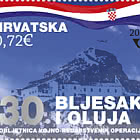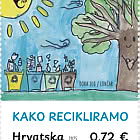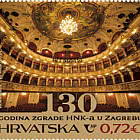The Archipelago of Palagruža is the most distant archipelago - part of the territorial land of the Republic of Croatia and a very important orientation point on the sailing route from Otranto towards the harbours of the Adriatic. On the importance of the sailing route through this corridor testify the remains of many shipwrecks underwater in the Archipelago. The Archipelago of Palagruža consists of two bigger islands – Great and Small Palagruža – three small islands (Kamik od tramuntane, Kamik od oštra and Galijul) and about fifteen rocks (Pupak, Volići, Gaće, Baba, Cufi etc). The Great Palagruža, with its peak at 87 meters above sea level and an area of 29 hectares is the highest and the largest island of the Archipelago. The sedimentary rocks of the Archipelago are a result of sedimentations through history and are about 135 million years old. They are remnants of the ancient mainland connected with Gargan, Tremiti, Sušac, Lastovo and Mljet.
The Archipelago was inscribed in nautical charts in the 14th century. Palagruža is 52 kilometres away from the Apennine Peninsula. Only 9 kilometres shorter distance to the nearest Croatian island - Sušac has procured to Palagruža Croatian sovereignty. The area is rich in fish and attracts many fishing companies from the islands of Vis, Lastovo and Hvar. There remained recorded the visit of the Pope Alexander III, who in 1177 disembarked on Palagruža on his way to Venice. The dinner was served to him on the flat area of Small Palagruža, today known as the Pope's Field.
In the time when the lighthouse was built, in 1875, first archaeological remains were found suggesting that Palagruža was inhabited far back in the Neolithic. The building of the lighthouse lasted two years and about two hundred workers worked on it. The light of a range of 25 nautical miles was lit for the first time in 1876. In the Aquarium of Palagruža many sea battles took place. In one of them in summer 1915 the Austrian Navy damaged the lighthouse, which was then renewed in 1923 by Italy, according to original projects.
The lighthouse building on Palagruža is the largest such object in the eastern Adriatic. Each floor has about two hundred square metres. In the vast ground floor there are working and side rooms of the lighthouse men while on the first floor there are two apartments. The light rotates at the height of 110 metres above the sea level. The water is brought from the mainland because the rain is scarce on Palagruža.
On Lastovo, island about fifty nautical miles away from Split, there is just one lighthouse – Struga. Austro-Hungarian architects have found the location in the central part of the south coast of the island, at the highest point of the promontory Struga. With its light beam the lighthouse marks during night the only safe shelter at the south coast of the island, the cove of Hidden harbour, in its far end, in the background of Struga. From its erection in 1839 the lighthouse is recognisable after its 20 metres high cylindrical tower. The light in the tower rotates at the height of 104 metres above sea level, and the lighthouse is one of the main orientation points when sailing on open seas in this part of the Adriatic.
The lighthouse is connected by road with the main island harbour of Ubli. The lighthouse building is a vast ground floor building with an area of 222 square meters. The light was automated je in the twenties of the 20th century and in 2002 the building was fully restored and in it four touristic apartments have been arranged. The lighthouse is today connected to the island's electric network, while the old cistern accumulates rain water and secures drinking and hygienic water to the family of lighthouse men and to tourists who spend there even up to several months per year. The cliff beneath the lighthouse is about 89 metres high and continues in the undersea area, sinking about eighty meters deep into the blueness. The particularity of this Adriatic lighthouse is that it is the only construction serving for safe navigation which for more than one century has been taken care of by the lighthouse men from one family - Kvinata - grandfather, followed by the father of today's lighthouse man Jurica Kvinta.
In the darkness of the underwater abyss beneath the cliff with the lighthouse many big fishes and crabs were caught. Attractive undersea walls are crisscrossed by a number of gaps and caves adorned with the populations of Adriatic red coral. Under this cliff the coral branch weighting 45 kilograms was taken ashore and in the same place the biggest crab in the Adriatic - a lobster weighting 18 kilograms was caught.
Sušac, an island at open sea, is 23 nautical miles away from the island of Hvar and 13 miles from the island of Lastovo. At windy weather the island is completely cut off from the world. The reach of its light beam is 24 nautical miles and because of its importance for the national navigation security system, a reserve light has also been installed with the light range of 12 nautical miles, which is lit when the mail light beam ceases to function. The lighthouse is automated and the two-person crew alternates at the end of the month.
The island of Sušac has an area of six square kilometres. The south, at some points inaccessible shores sink steeply into the blueness. The natural island phenomenon is a sea lake in the north-east part, hidden behind the shore cliff. It is connected with the sea through narrow underwater passage about ten metres beneath the surface. On the island there are remains of the settlement which once had about two hundred inhabitants. The testimony of the civilisation are also the remains of the two small churches, one originating from the 4th century.
The island is stretched in the north- south direction. Opposite ends of the island end with elevations connected in the central part with the low island's ridge. The north part of the island is dominated with the 239 metres high peak. On the south peak of the island there stands a huge lighthouse building. When the silhouette of the island appears in the horizon, the low island's ridge creates an impression that there are two islands and not just one. This optical deception sometimes, before the lighthouse was erected, caused confusion with salesmen and they reversed the prows of their vessels in other directions convinced that they had wandered off the planned navigating route.
The lighthouse was built in 1878, on an elevation 80 metres above the sea level. The lighthouse building, a stone one-storied construction with the tower in the central part, is among the biggest in the Adriatic. From the east, the lighthouse is encircled by an old wall. The lighthouse men spend their time in the ground floor, while on the floor there are two touristic apartments. Yearly precipitations on the island are from about ten to about twenty litres per square metre, so that the cistern always had to be supplemented by water carriers. Deep blueness immediately beneath the cliff on which there is a lighthouse, has always presented a challenge for the divers. About some of them, who forever remained in the blue depths, evidences the stone memorial engraved in the cliffs of the promontory of Triščavac, northeast from the lighthouse.






























